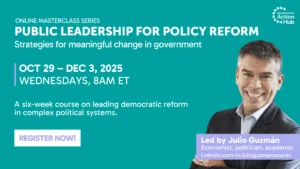Global Masterclass Series on Public Leadership
We’re thrilled to launch a global masterclass on “Democratic Public Leadership for Policy Reform”, a 6-week online series designed for anyone passionate about public leadership, advocacy, and social change.
Whether you’re a student curious about governance, an activist driving change or experienced in the policy world, this series seeks to inspire and inform meaningful reform, through real-world tools, honest leadership lessons, and stories from the frontlines. The sessions will be live and are designed to foster interactive engagement.
Led by Julio Guzmán, R4D Senior Fellow and Governance Explorer, former Peruvian presidential candidate and senior policymaker who now directs international programs at the University of Maryland. He brings decades of national and global policy leadership experience.
Details:
- Every Wednesday for 6 weeks, from Oct 29 – Dec 3 2025
- 8am – 9:30 am Eastern Standard Time
- Online (Zoom)
- Free
BONUS: Participate in all six sessions to stand a chance to receive one-on-one coaching sessions with Julio Guzmán!
SERIES THEMES
Session 1: The Reformist Leader | 29 October
Public Leadership. What is public leadership? Difference between leadership in the public and private sector. The relationship between leadership, power, and authority. Key leadership challenges in government. Why pursue leadership in the public arena?
Policy Reform. What is policy reform? Understanding behavior change as a prerequisite for policy reform. Reform vs. revolution. Types of policy reform: laws vs. programs. Reform vs. modernization. Why technocratic approaches often fall short.
Session 2: Policy First, Politics Second | 5 November
Recognizing a Public Problem. What is a public problem? Is it truly a problem? Do citizens—or the intended beneficiaries—perceive it as such? Has the problem already entered the public’s consciousness, or is it being introduced as a new issue? Is the problem a priority for citizens?
Identifying Policy Solutions. Are there viable policy solutions that warrant government intervention? If so, how feasible are they? What resources—technical, financial, political, and institutional—are required for implementation? What is the estimated timeline? The importance of involving non-technocratic actors in policy design.
Balancing Strategy and Quick Wins. How can long-term reform goals be anchored? The role of quick wins—tactical policy and political achievements—in fueling momentum for strategic reform.
Session 3: Stories Win Hearts and Minds | 12 November
Crafting the Narrative. Building an emotionally resonant and accessible story—one that even a child could understand— to push forward policy reform. Going beyond explaining the “how” by helping people imagine the future. Developing a storyline: problem, knot, solution. Tailoring the narrative for different audiences—citizens, technocrats, and politicians?
Communicating the Narrative. Maintaining consistency in messaging. Who should communicate the story? How often, when, and through which channels? Best practices for effective policy storytelling.
Session 4: Understanding How the System Works | 19 November
The Architecture of the State. A reality check on policy reform: you can’t squeeze a Hummer through the streets of Rome. Understanding the mandates and authority of ministries, agencies, and programs. The Golden Rule: “Whoever has the gold makes the rules”—the psychology and influence of finance ministries and political actors in higher positions of power.
The Rules of the Game. Which state institutions have formal stakes in the policy area in question? Understanding the administrative systems necessary for reform—budgeting, public investment planning, financial management, control and accountability, and procurement.
The Reform Process. How is policy reform passed? An overview of the formal policy process: the bureaucratic bodies responsible for design, review, approval, and implementation. The formal political process: the roles of the Executive, Legislature, and Judiciary. Understanding the position of the public leader within this framework—navigating institutional constraints and leveraging opportunities.
Session 5: Stakeholder Involvement and Building Political Will | 26 November
Mapping Interest Groups. Who stands to gain or lose from the proposed reform—within and outside government? Businesses, unions, political parties, religious institutions, the military, farmers, exporters, students, indigenous communities, actors involved in illicit activities, and foreign stakeholders. Are they aware of the reform? Do they know they will be affected?
Analyzing Power Dynamics. Are these groups organized? Do they coordinate or collaborate? What kind of leverage do they hold? What does past experience reveal about their influence? Where does the public leader fit within the broader power landscape? How can unorganized allies be mobilized?
Understanding Key Players. Reading the personalities, values, and motivations of those leading major interest groups. Personal ambitions, strengths, weaknesses, hopes, and fears. Navigating egos and using emotional intelligence as a tool for negotiation.
Thinking Politically. How to build alliances, negotiate effectively, and manage tension among competing interests. Should leaders meet only with allies? Policy reform negotiation strategies—propose a horse, expect a camel. Being willing to relinquish authorship of a reform in order to secure its success. The number one rule of power: never outshine your master.
Session 6: How to Survive | 3 December
The Personal Cost of Leading Reform. Tactics used by opponents—ridicule, diversion, attack, and temptation. How to endure personal and professional pressure when both the reform and the leader are under public scrutiny.
Managing Emotional Strain. How to stay grounded emotionally. Strategies for depersonalizing the reform process, during and after implementation. Cultivating a mindset that does not expect recognition or gratitude.

